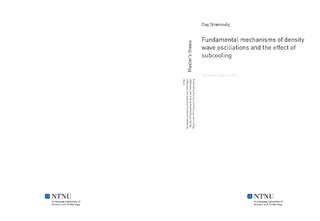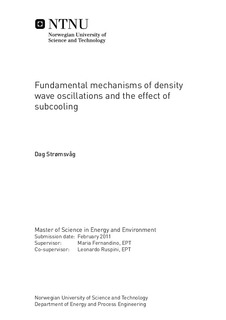| dc.description.abstract | Boiling two-phase flow is found in many industrial applications such as boiling water reactors, two-phase flow heat exchangers and refrigeration systems. The physics of two-phase gas-liquid flow may lead to undesirable system instabilities, and in the literature density wave oscillations (DWO) is reported to be the most commonly observed instability phenomenon. However, the literature alsoprovides two opposing views on what the fundamental mechanism of DWO is. The so-called classical description of DWO focuses on the variation in mixture density as the governing mechanism, and the oscillation period will consequently be about one to two times the channel residence time. The findings presented in citet{Rizwan-Uddin1994} show that it is the variation in mixture velocity that hasthe dominating effect, and the oscillation period was reported to be closer to four times the channel residence time. citet{Ambrosini2000} united the two opposing views by stating that the governing mechanismdepends on the level of system subcooling. The classical description of DWO is based on a lower level of subcooling, while citet{Rizwan-Uddin1994} considered higher subcooling. Here, the fundamental mechanisms of DWO and the effect of system subcooling is investigated further by performing a numerical analysis using a one dimensional homogenous equilibrium flow model. The modeled system consists of a horizontal uniformlyheated boiling channel with an inlet- and exit restriction. The system is exposed to constant externally imposed pressure drop. The effect of system subcooling is investigated by comparing the self-sustained periodicoscillations which make out the modeled stability threshold. The flow model is validated by observing the above mentioned effects of subcooling on DWO. Further, it is found that the change from a density dominated exit restriction towards a velocity dominated exit restriction is a smooth transition for increased subcooling. The amplitude of the variations in exit mixture velocity increases continuously with subcooling, anddue to the squared relationship between the exit restriction pressure drop and the exit mixture velocity, velocity becomes the governing mechanism at high subcooling.The modeled stability threshold approaches a straight line at high subcooling. This line represents operating conditions which have the same mean boiling boundary location. However, the amplitude of the variations about this mean limit grows exponentially at high subcooling. The oscillation period of the observed DWO grows continuously with higher subcooling, and the period increases exponentially at high subcooling. In contrast, the mean boiling channel residence time approaches an upper mean limit at high subcooling. It is postulated that it is the transition towards a more mixture velocity dominated system that causes the oscillation period to evolve as it does with respect to the level of subcooling. | nb_NO |

